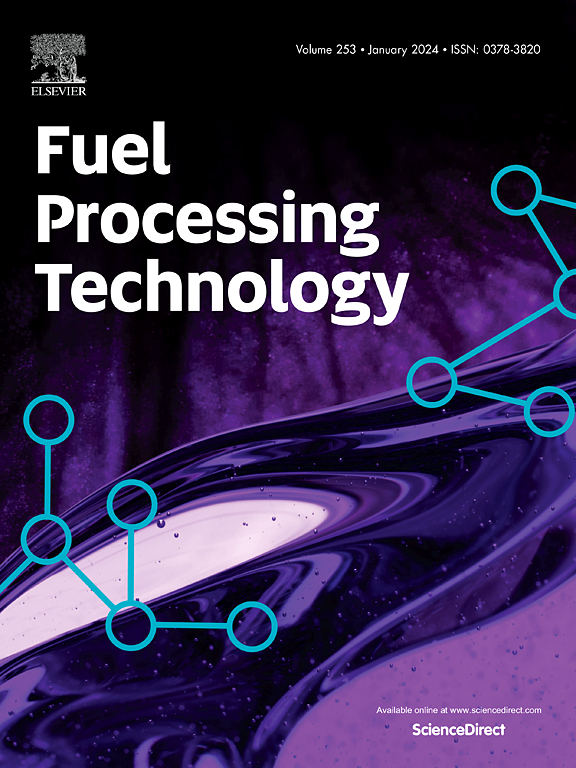Evaluation of diesel fuel production from bio-oils hydrodeoxygenation using unsupported MoS2 catalysts
IF 7.7
2区 工程技术
Q1 CHEMISTRY, APPLIED
引用次数: 0
Abstract
Diesel production from lignocellulosic biomass-derived fast pyrolysis bio-oil (FPBO) and catalytic pyrolysis bio-oil (CPBO) was investigated with an upgrading approach using unsupported MoS2 catalysts generated in situ. Hydrodeoxygenation of FPBO and CPBO was evaluated in a continuous-flow reactor system using feed blends containing 18 wt% bio-oil in fuel oil. For FPBO, 92.9 % deoxygenation was achieved with 0.51 wt% O in oil products, resulting in low acidity (0.32 mg KOH/g), while 74.8 % deoxygenation was obtained for CPBO with 1.24 wt% O and 0.48 mg KOH/g acidity in oil products. The lower deoxygenation of CPBO suggests that oxygenates in CPBO are less reactive than those in FPBO. In both cases, low solid yields were observed from 1.2 to 2.0 g/100 g bio-oil. XRD and HRTEM detected few-layer stacked structure for the in-situ formed MoS2 catalysts. The oil product from CPBO retained more biogenic carbon than from FPBO, with the diesel fraction from CPBO exhibiting a higher biogenic carbon content and yield. Both diesel cuts meet almost all ASTM D975 specifications, except for S content, resulting from the high S/Mo feed ratio used in the tests. Evaluation results demonstrated great potential for producing specifications-conforming diesel fractions from FPBO and CPBO upgrading using unsupported MoS2 catalyst.
无负载二硫化钼催化剂催化生物油加氢脱氧生产柴油的研究
研究了木质纤维素生物质衍生快速热解生物油(FPBO)和催化热解生物油(CPBO)在原位生成的无负载二硫化钼催化剂上的升级换代方法。在连续流反应器系统中,使用燃料油中含有18 wt%生物油的混合料,对FPBO和CPBO的加氢脱氧进行了评价。对于FPBO,当油中O含量为0.51 wt%时,脱氧率为92.9%,酸度较低(0.32 mg KOH/g);而对于CPBO,当油中O含量为1.24 wt%,酸度为0.48 mg KOH/g时,脱氧率为74.8%。CPBO的低脱氧表明CPBO中的氧合物比FPBO中的氧合物活性更低。在这两种情况下,每100克生物油的固体产量从1.2克到2.0克都很低。XRD和HRTEM检测到原位形成的二硫化钼催化剂具有少层堆积结构。CPBO的成品油比FPBO保留了更多的生物碳,CPBO的柴油馏分表现出更高的生物碳含量和产率。除了S含量外,这两种柴油切割几乎满足所有ASTM D975规格,这是由于测试中使用的高S/Mo进料比造成的。评估结果表明,使用无负载的MoS2催化剂,FPBO和CPBO升级生产符合规格的柴油馏分具有很大的潜力。
本文章由计算机程序翻译,如有差异,请以英文原文为准。
求助全文
约1分钟内获得全文
求助全文
来源期刊

Fuel Processing Technology
工程技术-工程:化工
CiteScore
13.20
自引率
9.30%
发文量
398
审稿时长
26 days
期刊介绍:
Fuel Processing Technology (FPT) deals with the scientific and technological aspects of converting fossil and renewable resources to clean fuels, value-added chemicals, fuel-related advanced carbon materials and by-products. In addition to the traditional non-nuclear fossil fuels, biomass and wastes, papers on the integration of renewables such as solar and wind energy and energy storage into the fuel processing processes, as well as papers on the production and conversion of non-carbon-containing fuels such as hydrogen and ammonia, are also welcome. While chemical conversion is emphasized, papers on advanced physical conversion processes are also considered for publication in FPT. Papers on the fundamental aspects of fuel structure and properties will also be considered.
 求助内容:
求助内容: 应助结果提醒方式:
应助结果提醒方式:


